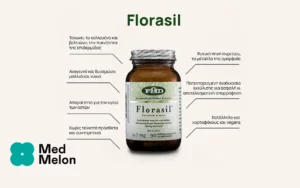Scientific Names:
Polentilla erectus (L.) Rδuschel (syn. P. tormentilla Stokes) [Fam. Rosaceae]
Forms:
Powder, tea, and tincture made from the chopped or crushed rhizomes (underground stems (sometimes erroneously called roots)) of Potentilla erecta.
Traditional Usage:
– Allergies
– Anti-inflammatory
– Antioxidant
– Antiviral
– Astringent
– Colitis
– Diarrhea
– Dysentery
– Gastroenteritis
– Gingivitis
– Heart Health Maintenance
– Immune System
– Mouth and Throat Inflammation
– Skin Problems
– Vascular Disorders
Overview:
Tormentil, Potentilla erecta (L.) Rauschel (syn. P. tormentilla Stokes) [Fam. Rosaceae], also known as English Sarsaparilla and Septfoil, is an herb common in central and northern Europe. The astringent and tonic properties of the rhizomes are used in many prepared herbal teas and remedies for diarrhea and digestive problems. Because of tormentil rhizome’s high tannin content, it has also been used for acute and sub-acute gastroenteritis, enterocolitis and dysentery. As rinse or gargle, tormentil rhizome preparations also help with inflammation of the mouth and throat. The German Commission E monograph recommends tormentil rhizome for treating non-specific acute diarrhea, and mild inflammation of the mucous membranes of the mouth and throat. The German Standard License recommends it for non-bacterial inflammation of the gums and mucous membranes of the mouth (gingivitis, stomatitis), pressure spots caused by prostheses, and acute non-specific diarrhea. Tannins reduce water within the bowel and ‘dry-up’ loose stools. Studies done on tannin extracts from Potentilla anserina for treating diarrhea show that they also antagonize the laxative effect of Rheum, Rhamnus and Senna in a “predictable” way. Several studies have also been done on the antioxidant activity of tormentil rhizome preparations. A standardized water-soluble extract of procyanidins isolated from rhizomes of tormentil was fractionated according to degree of polymerization and the anti-radical activities of the different fractions towards superoxide anions were compared. It was found that the most active procyanidins were pentamers and hexamers (oligomeric proanthocyanidins – OPCs). Other studies on procyanidins extracted from the rhizomes of Potentilla tormentilla found that dimers and trimers displayed the highest anti-radical activity towards lipoperoxidation, while pentamers and hexamers possessed the most marked anti-elastase properties (vascular-protective effects). Tormentil rhizome extracts also have demonstrated anti-allergic, anti-hypertensive, antiviral, immuno-stimulant and interferon-inducing actions. However, these claims are still being investigated. Interestingly, OPCs from grapeseed have similar indications.
Active Ingredients:
Tormentil root contains 15-20% tannins (mainly the catechol type), which on storage are slowly converted into phlobaphenes; besides the polymers, there is a series of monomers and dimers, e.g. flavan-3-ols and procyanidins, but catechol trimers are also known. The isolation of agrimoniin, a dimeric ellagitannin and the detection of gallic acid, ellagic acid, and catechol gallates make it clear that at least part of the tannins belongs to the group of hydrolysable tannins. According to K. Lund, the content of (hydrolysable) ellagitannins is 6.2%, which, being 37% of the total tannin content of 21.6%, means that they are over-represented in the overall effect that the tannins have. Other constituents worth mentioning are: the pseudosaponin tormentoside (aglycone: the triterpene tormentillic acid), quinovic acid, phenylpropanes such as caffeic, p-coumaric, and sinapic acids, as well as traces of essential oil.
Suggested Amount:
Tormentil root may be taken as a tea or tincture. According to the German Commission E monograph, the recommended daily dose of tormentil root is 4-6 grams. If diarrhea persists for more than 3 or 4 days, consult a physician. Tincture: 10-20 drops per one cup of water several times a day as a mouth and throat rinse. To make the infusion, place 2-3 grams (1 teaspoon = 4 grams) of finely or coarsely chopped tormentil root into cold water and bring to a boil. Let stand briefly, then strain. Cold maceration is also worthwhile, since prolonged boiling leads to hydrolysis of the ellagitannins and reduced activity. For diarrhea, take 2-4 grams of powered tormentil root and suspend in red wine. As an anti-diarrheic, a cup of the tea or suspension in wine may be taken three or four times per day.
Drug Interactions:
None known.
Contraindications:
None known.
Side Effects:
Tormentil root preparation may cause stomach complaints and vomiting in susceptible persons.
References:
Bos MA, Vennat B, Meunier MT, Pouget MP, Pourrat A, Fialip J. Procyanidins from tormentil: antioxidant properties towards lipoperoxidation and anti-elastase activity. Biol Pharm Bull. 1996 Jan; 19(1): 146-8.
De Smet, P., Keller, K., Hansel, R. and R. Chandler (eds.) 1993. Adverse Effects of Herbal Drugs. Springer-Verlag New York Berlin Heidelberg. Pp. 66.
Tunon H, Olavsdotter C, Bohlin L. Evaluation of anti-inflammatory activity of some Swedish medicinal plants. Inhibition of prostaglandin biosynthesis and PAF-induced exocytosis. J Ethnopharmacol. 1995 Oct; 48(2): 61-76.
Vennat B, Bos MA, Pourrat A, Bastide P. Procyanidins from tormentil: fractionation and study of the anti-radical activity towards superoxide anion. Biol Pharm Bull. 1994 Dec; 17(12): 1613-5.
Wichtl M and NG Bisset (eds). 1994. Tormentillae rhizoma – Tormentil, Potentilla. In Herbal Drugs and Phyto-pharmaceuticals. (English translation by Norman Grainger Bisset). CRC Press, Stuttgart, pp. 499-501.




